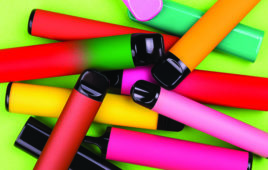Espresso and cappuccino are hot in more ways than one these days. Espressois an Italian-style coffee, usually made by the cup, using high-pressure hotwater forced through finely roasted coffee to create the distinct potency andflavor. Cappuccino is espresso mixed with steamed milk and frothed milk. Bothespresso and cappuccino and similar drinkslatte and cafè au lait,for instanceare steaming up sales in c-stores throughout the country.
Espresso machines vary widely, from models requiring an operator’s skill to render a good cup, to the sophisticated models capable of producing a perfectly portioned espresso with the touch of a single button. While not typically found in convenience stores, there are also vending models and units made for self-service.
Espresso makers vary in size, capabilities and ease of operation. A match to a retailer’s expected volume is easy to make once an operator decides on the degree of sophistication required. There are two basic types of machines most often used in the convenience store market. First, there is the instant automatic machine. This type of machine uses a frozen concentrate coffee product and can dispense several types of coffeeusually espresso, cappuccino or even a cafè au lait or flavored coffee beverage. These machines can be purchased, but in many instances coffee concentrate vendors supply them.
Most of the concentrate machines are compact countertop models that take upa minimal amount of space. Most measure about 12″ to 18″ wide. Thereare also a few floor-mounted units for stores wanting to feature the machinearound other instore elements. The machines require similar hook-up requirementsto a regular coffee maker, such as water lines, drain connections and accessto a 120-volt electrical outlet.
The quality of espresso from a frozen concentrate dispenser has improved dramatically in the past few years to the point that these instant machines produce a solid beverage. The convenience is certainly a strong selling point: no mess to deal with and very little in the way of problems a customer can experience in using the equipment to create their beverages.
At the other end of the spectrum, some stores are looking for the gourmet touch. Super-automatic espresso makers similar to those in high-end restaurants or cafès have made their way into some convenience store operations. Fully-automatic machines produce a high-quality consistent espresso with minimal waste and little chance for operator error.
These machines might feature coffee bean hoppers on the top of the unit andhave a sleek European look, but they are made for customer use. Customers feellike they are really making a fresh quality cup of coffeeand they are!The machines produce an excellent fresh-brewed cup of espresso with no knowhowrequired. A number of other specialty coffee drinks can also be made at thetouch of a button. The big advantage to the retailer is the perceived qualityand the healthy margins offered by higherpriced coffee drinks.
The sizes and machine requirements are similar to the concentrate machines although some require a higher 208-/240-volt electrical outlet. The machines typically are more expensive and require more regular maintenance compared to the concentrate makers, but many operators find the additional investment is easily recouped through increased profits.
A final suggestion concerns the importance of the quality of water used inmaking coffee drinks. Espresso is about 98% water, making it a crucial ingredientin the drink. Having a good quality water filter for the espresso maker is essential.




